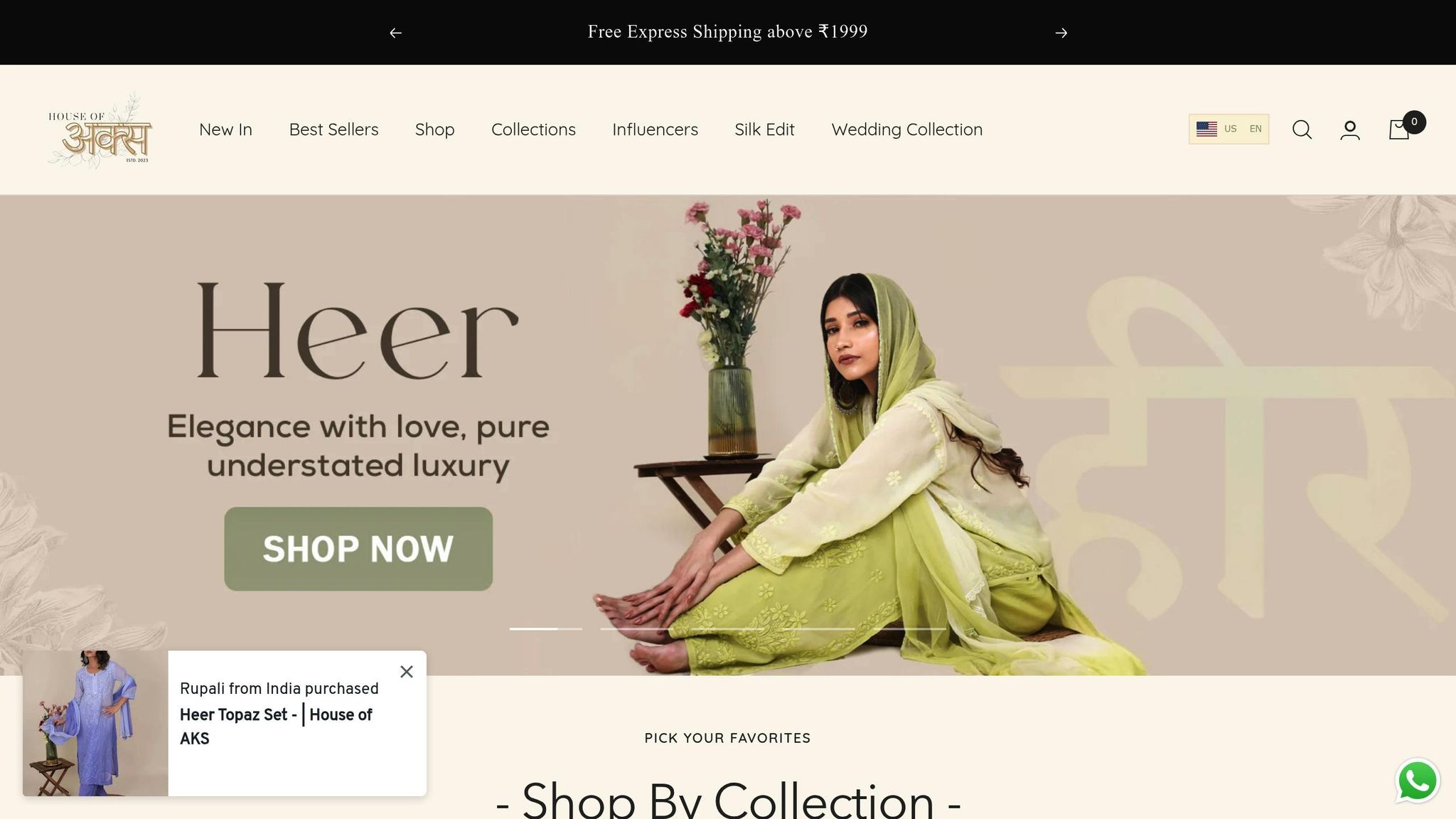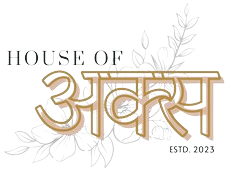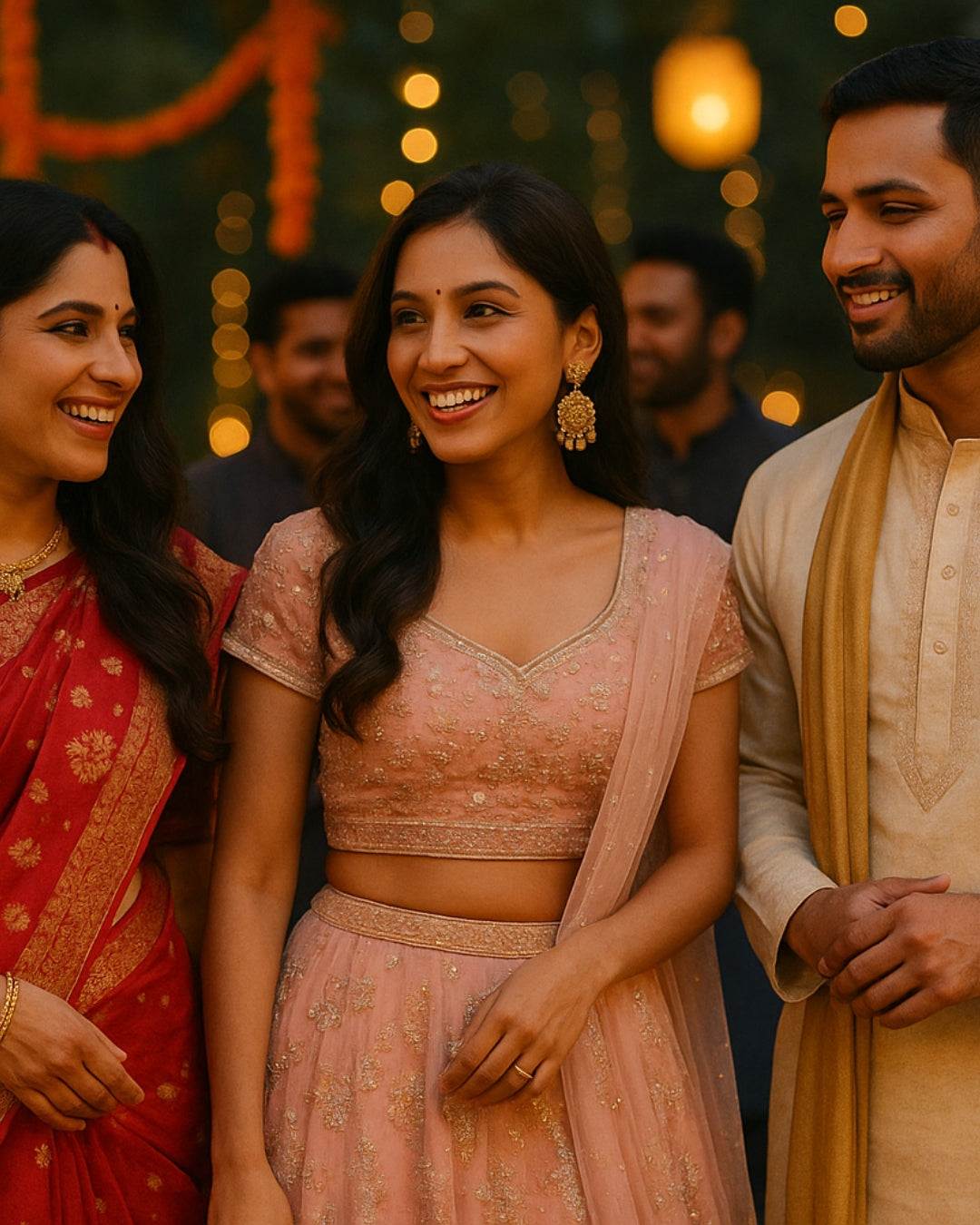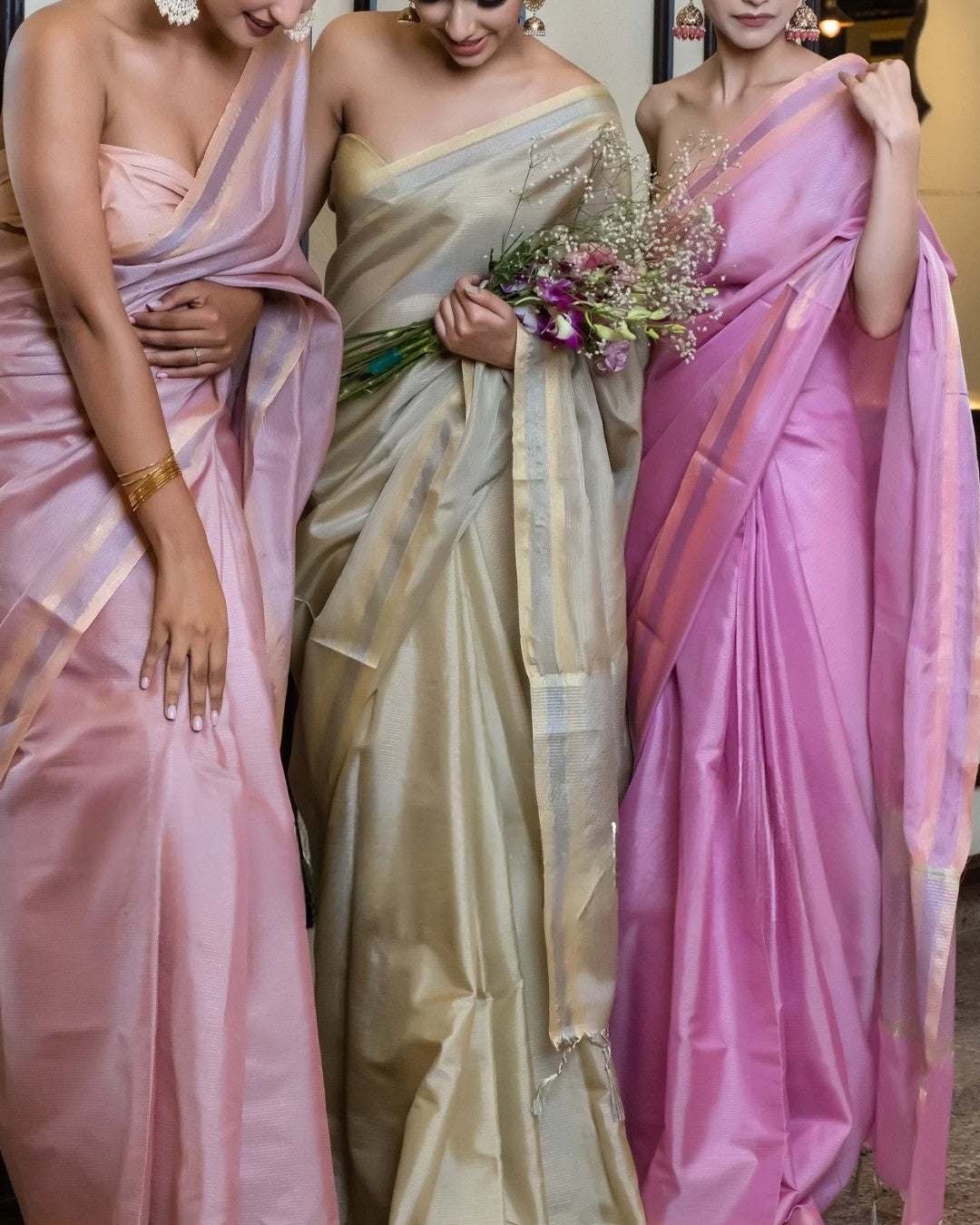Common Questions About Sustainable Indian Fashion
Eco-friendly Indian fashion combines age-old Indian craftsmanship with materials and methods that are better for the planet. It focuses on using natural, biodegradable fabrics like organic cotton, bamboo, and silk, along with techniques like handloom weaving and natural dyeing. This approach not only reduces waste and pollution but also supports artisans by ensuring fair wages and preserving traditional skills.
Key Points:
- Why It Matters: The global fashion industry contributes 10% of carbon emissions and 20% of wastewater. Eco-friendly fashion addresses these issues by promoting ethical production and reducing environmental harm.
- Indian Handcrafts: Crafts like Chikankari and Banarasi weaving use low-energy techniques and natural dyes, supporting both artisans and the environment.
- Benefits: Handcrafted garments like Chikankari and Banarasi last longer, reduce waste, and uphold India’s rich textile heritage. They also create jobs for over 7 million artisans.
- How to Identify: Look for natural fibres, handloom fabrics, and certifications like GOTS or India Handloom Brand. Authentic pieces often have charming imperfections that reflect the artisan's skill.
- Issues with Mass-Produced Fashion: Fast fashion relies on synthetic materials, exploits labour, and promotes a throwaway culture, threatening artisans and the ecosystem.
Quick Comparison:
| Aspect | Eco-Friendly Fashion | Mass-Produced Fashion |
|---|---|---|
| Environmental Impact | Uses natural dyes, reduces CO₂ emissions | High waste, synthetic materials harm ecosystems |
| Quality | Durable, handcrafted | Short-lived, low-quality |
| Support for Artisans | Fair wages, sustains skills | Exploitative labour practices |
| Cost | Higher upfront, better long-term value | Cheaper initially, hidden social costs |
By choosing eco-friendly Indian fashion, you are supporting artisans, reducing waste, and contributing to a cleaner, fairer world. Start small by investing in high-quality, handcrafted pieces with timeless appeal.
Benefits of Eco-Friendly Indian Fashion
How Green Practices Help the Planet
Eco-friendly fashion in India is all about reducing environmental harm by using traditional, low-energy techniques. For instance, handloom weaving like Banarasi silk relies on minimal energy and produces almost no waste, as artisans make the most of every thread and fibre.
Another key aspect is the use of natural dyes and local production, which helps protect ecosystems. Natural dyes, sourced from plants, minerals, and other organic materials, decompose naturally without polluting water systems. Compare this to synthetic dyes, which are responsible for nearly 20% of global wastewater from fabric dyeing and treatment processes. By choosing garments made with natural dyes, you're actively contributing to cleaner rivers and healthier ecosystems.
India’s handloom industry plays a major role on the global stage, accounting for 95% of the world's handloom exports. With local production and minimal energy use, handloom textiles significantly reduce carbon footprints, making them a valuable ally in the fight against climate change.
Eco-friendly materials like organic cotton, bamboo, and recycled fabrics further help lower the fashion industry’s contribution to global carbon emissions, which currently stands at 10%. Beyond the environmental benefits, these practices carry forward a rich cultural legacy tied to India’s heritage.
Preserving Heritage Through Handmade Clothing
Traditional Indian crafts (Chikankari & Banarasi silk) are more than just artistic expressions - they are a bridge to the past, preserving techniques and cultural stories that might otherwise fade away in today’s industrialised world. These handmade crafts represent centuries of refinement, passed down through generations.
This generational knowledge doesn’t just ensure exceptional quality; it also keeps the cultural essence of the craft (Chikankari & Banarasi Silk) alive. Families and communities play a vital role in safeguarding these skills, ensuring that the artistry remains intact alongside its historical context.
The Indian handicraft industry is a cornerstone of heritage preservation, employing over 7 million artisans and valued at approximately ₹2,07,500 crore. The handloom sector alone provides jobs to about 4.3 million people across the country, making it one of the largest efforts to preserve cultural heritage globally.
In recent years, traditional textiles have made a strong comeback in contemporary fashion, with handwoven fabrics taking centre stage. This revival highlights a growing appreciation for authenticity and the cultural depth behind fashion choices.
"Handwoven clothes are more than just a textile; it's a symbol of sustainable fashion, cultural heritage, and social responsibility."
- Lowie
While these crafts honor history, they also play a vital role in uplifting local communities.
Supporting Local Communities
Choosing Eco-friendly Indian fashion(Chikankari & Banarasi silk) does more than benefit the environment - it directly supports the livelihoods of millions of artisans and their families. This creates a ripple effect, strengthening entire communities and boosting regional economies.
Fair wages and ethical practices ensure artisans enjoy economic stability while preserving their traditional skills. Unlike large-scale manufacturing facilities, artisan communities often prioritise access to basic human rights like sanitation, healthcare, and education. These support systems help break cycles of poverty and inequality, providing artisans with a sustainable way of life.
"Integrating Indian handloom and handicraft with sustainable fashion is a great way to promote eco-friendly and socially responsible fashion."
Your support also helps protect traditional crafts that are at risk of disappearing due to globalisation. Recent estimates from the United Nations reveal that 30% of Indian artisans have left the trade in recent years, with one-third of textile artisans becoming unemployed in 2019. Every purchase of eco-friendly fashion helps sustain these invaluable crafts and the communities behind them.
When artisans earn fair wages, they reinvest in their local economies, creating a cycle of growth and cultural preservation. This is particularly impactful in economically challenged regions, where artisanship provides a dependable source of income and stability.
How to Spot Eco-Friendly Indian Garments
Recognizing Eco-Friendly Indian Garments
Spotting Eco-friendly Indian garments starts with paying attention to the fabric, craftsmanship, and finishing touches. Natural fibres like cotton, silk, linen, hemp, and bamboo often have an organic feel and texture that sets them apart.
Hand embroidery is another telltale sign, with its charming imperfections - slightly uneven stitches, subtle variations in thread tension, and even loose threads or knots on the reverse side. For instance, traditional techniques like Chikankari showcase intricate threadwork that reflects the skill of artisans.
Handloom fabrics often reveal their authenticity through irregularities in thread thickness and colour, a result of small-batch production that ensures each piece is one of a kind. These garments also tend to have a heavier weight and a natural drape, highlighting the quality of the fibres used.
To go beyond these visual and tactile cues, certifications play a key role in confirming a garment’s eco-friendly origins.
Certifications and Labels to Look For
Certifications from trusted authorities can help you verify the sustainability of Indian garments. Here are some key labels to check:
- India Handloom Brand: A government initiative that authenticates traditional handloom products while supporting artisan communities.
- GOTS (Global Organic Textile Standard): Ensures textiles are made from organic fibres and meet strict environmental and social standards across the supply chain.
- Silk Mark: Confirms the purity and authenticity of silk products.
- Fair Trade Certification: Guarantees fair wages and safe working conditions for workers.
- ECO Mark: Introduced by the Indian government in 1991, this label identifies products that meet ecological standards, symbolised by an earthen pot logo representing renewable resources.
- Organic Content Standard (OCS): Promotes the use of organic agricultural materials in textiles.
- ISO 14001: Focuses on environmental management systems to minimise ecological impact.
- Recycled Claim Standard (RCS) & Global Recycled Standard (GRS): Certify that recycled materials are responsibly sourced and processed.
Evaluating Brand Transparency
Once you've identified garments with eco-friendly features and certifications, the next step is to assess the brand's transparency. Start by visiting the brand’s website to see if they provide detailed insights into their supply chain, production methods, and partnerships with artisans. Look for specifics about material sourcing, the communities they work with, and whether they ensure fair wages.
Genuine sustainable brands often go the extra mile by sharing stories and visuals of their artisans and production processes. Their social media pages may also offer behind-the-scenes glimpses into community initiatives and eco-friendly practices.
Another good indicator is whether the brand publishes annual sustainability reports or impact assessments, offering measurable data on their environmental and social efforts. Collaborations with credible certification bodies or NGOs focused on artisan welfare add further credibility.
Lastly, customer reviews and testimonials can offer valuable clues about a brand’s transparency. If a product’s price seems unusually low for something claimed to be sustainably made, it’s worth digging deeper to understand why.
Eco-Friendly vs Mass-Produced Indian Fashion
Let’s dive into a comparison between eco-friendly and mass-produced Indian fashion to understand their distinct impacts and benefits.
Benefits of Eco-Friendly Fashion
Eco-friendly Indian fashion stands out for its long-lasting quality and lower environmental footprint. For example, organic cotton generates up to 46% less CO₂ compared to conventional cotton. Similarly, natural dyes and handloom fabrics avoid the use of harmful chemicals, making them a more sustainable option.
Research also shows that wearing garments for twice as long can cut emissions by 44%. By choosing handcrafted pieces like Chikankari kurtas or Banarasi sarees, you’re not just buying clothing - you’re helping to preserve age-old techniques and supporting regional economies. This choice directly contributes to the survival of artisanal traditions and community heritage.
Sustainable fashion like Chikankari & Banarasi silk also encourages a thoughtful approach to consumption. Instead of overloading your wardrobe, it promotes owning fewer, high-quality items that you genuinely value. This shift fosters a deeper appreciation for the craftsmanship behind each piece and nurtures a stronger connection with what you wear. As mentioned earlier, certifications and transparent supply chains further validate these benefits.
Problems with Mass-Produced Fashion
On the flip side, mass-produced fashion comes with significant environmental and social costs. For instance, manufacturing just one cotton T-shirt can consume as much as 2,700 litres of water. Additionally, synthetic fibre production is highly resource-intensive, requiring around 70 million barrels of oil annually. These materials often end up in landfills, where they can take centuries to decompose.
Labour conditions in mass production are another pressing issue. Many workers endure low wages and unsafe environments. This not only exploits individuals but also undermines India’s artisan communities, which have been the backbone of the country’s textile heritage.
Fast fashion also promotes a disposable mindset. When garments are designed for short-term use, the intricate skills of traditional Indian artisans are undervalued. Over time, this throwaway culture and market standardisation erode the uniqueness of regional styles, replacing them with generic, machine-made alternatives.
Side-by-Side Comparison
Here’s a quick comparison to highlight the key differences between eco-friendly and mass-produced Indian fashion:
| Aspect | Eco-Friendly Indian Fashion | Mass-Produced Indian Fashion |
|---|---|---|
| Environmental Impact | Organic materials and natural dyes reduce CO₂ emissions by up to 46% | High resource use; synthetic fibres require 70 million barrels of oil annually |
| Quality & Durability | Handcrafted pieces ensure longevity and encourage extended use | Low-quality materials lead to frequent replacements |
| Artisan Support | Provides fair wages and safe working conditions for artisans | Often involves exploitative labour and unsafe environments |
| Cultural Heritage | Preserves traditional techniques like Chikankari and Banarasi weaving | Threatens regional crafts through standardisation and mechanisation |
| Pricing Structure | Higher upfront cost but offers better long-term value | Lower initial price but hidden environmental and social costs |
| Production Methods | Focuses on small-batch, handcrafted items | Large-scale machine production with synthetic materials and chemical processes |
| Consumer Relationship | Encourages mindful ownership and lasting connections | Promotes a throwaway culture and impulsive buying habits |
This comparison clearly shows how eco-friendly fashion not only supports the environment but also uplifts communities and preserves cultural heritage, making it a meaningful alternative to mass-produced options.
Conclusion: Choosing Eco-Friendly Indian Fashion
Key Takeaways
Eco-friendly Indian fashion offers a way to reduce environmental harm while celebrating the rich textile traditions of India. When you invest in handcrafted garments, you're not just buying clothes - you’re helping preserve traditional techniques for future generations.
Another important aspect is supporting artisan communities. Brands that prioritise sustainable practices ensure fair wages and safe working conditions for rural craftspeople. This helps sustain the livelihoods of artisans across India, from the weavers of Varanasi to the skilled hands behind Lucknow's Chikankari embroidery.
Prioritising quality over quantity is essential. Instead of filling your wardrobe with fast fashion, choosing fewer, high-quality pieces helps you appreciate the skill and effort behind each garment while also cutting down on waste.
These principles form the foundation of House of AKS's commitment to sustainable fashion.
How House of AKS Champions Sustainable Fashion

House of AKS incorporates sustainability into every stage of its production. The brand collaborates directly with skilled artisans, many of whom are women carrying forward age-old traditions, ensuring that Indian handcrafts like Chikankari & Banarasi silk continue to thrive in today’s world.
"Our brand is not just about clothes - it's about preserving India's beautiful handcraft traditions and giving them a place in today's modern world."
- House of AKS
House of AKS places a strong emphasis on eco-conscious practices, from using high-quality fabrics and gentle, non-toxic dyes to avoiding harmful chemicals that could impact both the environment and artisans. Their commitment extends to packaging as well, with a focus on repurposing leftover materials and avoiding plastic wherever possible.
Examples of their work include Chikankari kurta sets crafted from organic cotton with natural dyes and Banarasi sarees woven using traditional methods. Even their packaging is designed to be reusable, reflecting their holistic approach to sustainability.
How to Add Eco-Friendly Fashion to Your Wardrobe
Incorporating eco-friendly Indian fashion into your daily life doesn’t mean replacing your entire wardrobe overnight. Start by making thoughtful choices - prioritise quality over quantity. Look for garments made from sustainable materials like organic cotton, handloom fabrics, or recycled fibres, ensuring they last for years rather than just a season.
Take time to research brands. Choose those that are transparent about their materials, production processes, and partnerships with artisans. Certifications like GOTS (Global Organic Textile Standard) or Fair Trade labels can help identify brands genuinely committed to sustainability.
Think about the long-term value of your purchases. While eco-friendly garments might come with a higher price tag initially, their durability and timeless design make them great investments. A well-made Chikankari kurta or handwoven saree can become a cherished part of your wardrobe for years to come.
Support brands that are committed to sustainable supply chains and eco-friendly packaging. Opt for companies that openly share their practices and focus on preserving traditional crafts while ensuring fair working conditions for artisans.
India’s sustainable fashion industry is growing at an impressive rate, with a projected 10% CAGR, driven by increasing consumer awareness and demand for ethical products. By making mindful choices today, you’re not just creating a sustainable wardrobe - you’re also contributing to a movement that values environmental care and the preservation of India’s rich heritage.
FAQs
How can I be sure that the sustainable Indian fashion I buy is truly eco-friendly and not just a marketing gimmick?
To make sure your Indian fashion choices align with eco-friendly practices, start by checking for recognised certifications like GOTS (Global Organic Textile Standard) or Fair Trade. These labels serve as a reliable stamp of approval, ensuring the garment adheres to global standards for ethical and sustainable practices.
It's also important to assess how transparent a brand is. Ethical brands openly share details about their sourcing, production methods, and partnerships with artisans. Be cautious of generic claims like "100% natural" or "eco-friendly" unless the brand provides clear evidence to support these statements. The most committed brands often showcase their efforts in supporting local crafts, minimising waste, or using organic materials.
Finally, think about the craftsmanship and origins of the clothing you buy. Opting for traditional Indian handcrafts like Chikankari or Banarasi weaving not only preserves cultural heritage but also supports the livelihoods of skilled artisans. This way, you contribute to a more ethical and sustainable fashion ecosystem while celebrating India’s rich textile traditions.
How do traditional Indian crafts benefit local communities and help preserve our cultural heritage?
Traditional Indian crafts hold immense importance in providing livelihood opportunities, especially for artisans in rural areas and marginalised groups like women, the elderly, and differently-abled individuals. By offering a means of income, these crafts contribute to economic development while promoting social inclusion. They also ensure that traditional skills and knowledge are preserved and passed down through generations.
Beyond their economic impact, these crafts are a living reflection of India’s rich heritage. Regional art forms like Chikankari embroidery or Banarasi weaving not only showcase intricate techniques but also preserve cultural motifs and traditions. They keep the essence of India’s identity alive, fostering a sense of pride among artisans and consumers alike. Supporting these crafts empowers communities and plays a vital role in maintaining a diverse and vibrant cultural legacy.
How can I start incorporating sustainable Indian fashion into my wardrobe?
To bring a touch of sustainable Indian fashion to your wardrobe, start by opting for eco-conscious fabrics like khadi, organic cotton, linen, or hemp. These materials not only minimise environmental impact but also provide much-needed support to local artisans who pour their skill and dedication into crafting them. Explore handcrafted or handloom creations such as Chikankari, Banarasi, or ikat, which celebrate the artistry of traditional Indian textiles.
Shift your focus to quality over quantity by choosing timeless, well-made pieces that stand the test of time. Revive old outfits by upcycling them into fresh designs or repairing items instead of tossing them out. You can also cut down your carbon footprint by washing clothes in cold water and letting them air-dry rather than using a dryer. These small but thoughtful steps not only help you create a stylish and sustainable wardrobe but also honour the rich legacy of Indian textiles.




